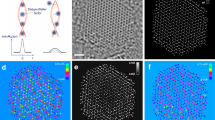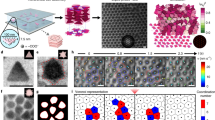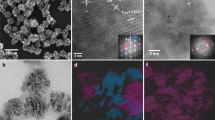Abstract
Surface atoms have fewer interatomic bonds than those in the bulk that they often relax and reconstruct on extended two-dimensional surfaces. Far less is known about the surface structures of nanocrystals. Here, we show that coherent diffraction patterns recorded from individual nanocrystals are very sensitive to the atomic structure of nanocrystal surfaces. Nanocrystals of Au of 3–5 nm in diameter were studied by examining diffraction intensity oscillations around the Bragg peaks. Both results obtained from modelling the experimental data and molecular dynamics simulations strongly suggest inhomogeneous relaxations, involving large out-of-plane bond length contractions for the edge atoms (∼0.2 Å); a significant contraction (∼0.13 Å) for {100} surface atoms; and a much smaller contraction (∼0.05 Å) for atoms in the middle of the {111} facets. These results denote a coordination/facet dependence that markedly differentiates the structural dynamics of nanocrystals from bulk crystalline surfaces.
This is a preview of subscription content, access via your institution
Access options
Subscribe to this journal
Receive 12 print issues and online access
$259.00 per year
only $21.58 per issue
Buy this article
- Purchase on Springer Link
- Instant access to full article PDF
Prices may be subject to local taxes which are calculated during checkout




Similar content being viewed by others
References
Bohnen, K. P. & Ho, K. M. Structure and dynamics at metal surfaces. Surf. Sci. Rep. 19, 99–120 (1993).
Smoluchowski, R. Anisotropy of the electronic work function of metals. Phys. Rev. 60, 661 (1941).
Finnis, M. W. & Heine, V. Theory of lattice contraction at aluminium surfaces. J. Phys. F 4, L37 (1974).
Pauling, L. Atomic radii and interatomic distances in metals. J. Am. Chem. Soc. 69, 542–553 (1947).
Ibach, H. The role of surface stress in reconstruction, epitaxial growth and stabilization of mesoscopic structures. Surf. Sci. Rep. 29, 195–263 (1997).
Valden, M., Lai, X. & Goodman, D. W. Onset of catalytic activity of gold clusters on titania with the appearance of nonmetallic properties. Science 281, 1647 (1998).
Gilbert, B., Huang, F., Zhang, H., Waychunas, G. A. & Banfield, J. F. Nanoparticles: Strained Stiff. Sci. 305, 651–654 (2004).
Alivisatos, A. P. Semiconductor clusters, nanocrystals, and quantum dots. Science 271, 933–937 (1996).
Marks, L. D. Experimental studies of small particles structures. Rep. Prog. Phys. 57, 603 (1994).
Cleveland, C. L. et al. Structural evolution of smaller gold nanocrystals: The truncated decahedral motif. Phys. Rev. Lett. 79, 1873 (1997).
Balerna, A. et al. A structural investigation on small gold clusters by EXAFS. Surf. Sci. 156, 206–213 (1985).
Menard, L. D. et al. Metal core bonding motifs of monodisperse icosahedral Au-13 and larger Au monolayer-protected clusters as revealed by X-ray absorption spectroscopy and transmission electron microscopy. J. Phys. Chem. B 110, 14564–14573 (2006).
Zhang, P. & Sham, T. K. X-ray studies of the structure and electronic behavior of alkanethiolate-capped gold nanoparticles: The interplay of size and surface effects. Phys. Rev. Lett. 90, 245502 (2003).
Jadzinsky, P. D., Calero, G., Ackerson, C. J., Bushnell, D. A. & Kornberg, R. D. Structure of a thiol monolayer-protected gold nanoparticle at 1.1 angstrom resolution. Science 318, 430–433 (2007).
Haruta, M. Catalysis of gold nanoparticles deposited on metal oxides. Catal. Technol. 6, 102 (2002).
Freund, H.-J., Libuda, J., Baumer, M., Risse, T. & Carlsson, A. Clusters, facets and edges: Site-dependent selective chemistry on model catalysts. The Chem. Record 3, 181 (2003).
Williams, G. J., Pfeifer, M. A., Vartanyants, I. A. & Robinson, I. K. Three-dimensional imaging of microstructure in Au nanocrystals. Phys. Rev. Lett. 90, 175501 (2003).
Pfeifer, M. A., Williams, G. J., Vartanyants, I. A., Harder, R. & Robinson, I. K. Three-dimensional mapping of a deformation field inside a nanocrystal. Nature 442, 63–66 (2006).
Foiles, S. M., Baskes, M. I. & Daw, M. S. Embedded-atom-method functions for the fcc metals Cu, Ag, Au, Ni, Pd, Pt, and their alloys. Phys. Rev. B 33, 7983–7991 (1986).
Haftel, M. I., Bernstein, N., Mehl, M. J. & Papaconstantopoulos, D. A. Interlayer surface relaxations and energies of fcc metal surfaces by a tight-binding method. Phys. Rev. B 70 (2004).
van Hove, M. A. et al. The surface reconstructions of the (100) crystal faces of iridium, platinum and gold.1. Experimental-observations and possible structural models. Surf. Sci. 103, 189–217 (1981).
Rieder, K. H., Engel, T., Swendsen, R. H. & Manninen, M. A helium diffraction study of the reconstructed Au(100) surface. Surf. Sci. 127, 223–242 (1983).
Heyraud, J. C. & Metois, J. J. Equilibrium shape of gold crystallites on a graphite cleavage surface–surface energies and interfacial energy. Acta Metall. 28, 1789–1797 (1980).
Landau, L. D. & Lifshitz, E. M. Theory of Elasticity (Butterworth-Heinemann, Oxford, 1986).
Harder, R., Pfeifer, M. A., Williams, G. J., Vartaniants, I. A. & Robinson, I. K. Orientation variation of surface strain. Phys. Rev. B 76, 115425 (2007).
Shibue, T., Nakanishi, T., Matsuda, T., Asahi, T. & Osaka, T. Thermal desorption high-resolution mass spectrometry of mixed self-assembled monolayers on gold. Langmuir 18, 1528–1534 (2002).
Kondoh, H., Kodama, C., Sumida, H. & Nozoye, H. Molecular processes of adsorption and desorption of alkanethiol monolayers on Au(111). J. Chem. Phys. 111, 1175–1184 (1999).
Bonzel, H. P. 3D equilibrium crystal shapes in the new light of STM and AFM. Phys. Rep. 385, 1–67 (2003).
Iijima, S. & Ichihashi, T. Structural instability of ultrafine particles of metals. Phys. Rev. Lett. 56, 616–619 (1986).
Acknowledgements
The work was supported by NSF Career Award, DMR 0449790 (W.J.H., J.M.Z.), DOE DEFG02-01ER45923 (R.S., J.T., J.M.Z.) and DEFG02-03ER15476 (R.G.N., L.D.M.). The electron microscopy work was carried out in the Center for Microanalysis of Materials, University of Illinois, which is partially supported by the US Department of Energy under grant DEFG02-91-ER45439.
Author information
Authors and Affiliations
Contributions
W.J.H., R.S., J.T. and J.M.Z. carried out the diffraction experiment, modelling and analysis. L.D.M. and R.G.N. carried out particle synthesis.
Corresponding author
Supplementary information
Supplementary Information
Supplementary figures S1–S4 (PDF 663 kb)
Rights and permissions
About this article
Cite this article
Huang, W., Sun, R., Tao, J. et al. Coordination-dependent surface atomic contraction in nanocrystals revealed by coherent diffraction. Nature Mater 7, 308–313 (2008). https://doi.org/10.1038/nmat2132
Received:
Accepted:
Published:
Issue Date:
DOI: https://doi.org/10.1038/nmat2132
This article is cited by
-
Imaging the facet surface strain state of supported multi-faceted Pt nanoparticles during reaction
Nature Communications (2022)
-
Tunable Band Gap and Raman Shifts of Two-Dimensional ReX2 (X=S, Se): Layer and Temperature Effect
Journal of Electronic Materials (2022)
-
Computational study of the effect of size and surface functionalization on Au nanoparticles on their stability to study biological descriptors
Journal of Molecular Modeling (2022)
-
Single-atom level determination of 3-dimensional surface atomic structure via neural network-assisted atomic electron tomography
Nature Communications (2021)
-
Free log-likelihood as an unbiased metric for coherent diffraction imaging
Scientific Reports (2020)



